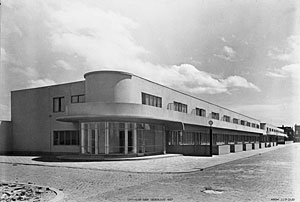For architects on the edge, early success can be a sword that cuts both ways.
Early adulation can morph into a fearsome burden, the “how-do-I-top-myself?” syndrome that frequently shadows exceptional success. Sometimes external factors interject a negative answer to that question. Shifting trends in taste thwarted the prospects of several early-20th-century vanguard architects, including Louis Sullivan, Charles Rennie Mackintosh, C.F.A. Voysey, and the Greene brothers, all of whom were labeled old hat when a resurgent vogue for Beaux-Arts Classicism — which Sullivan foresaw at the 1893 Chicago World’s Fair — reared its neo-Roman head.

Gwathmey prided himself on not jumping aboard the Postmodern bandwagon, unlike his opportunistic colleagues. But he didn’t go broke by sticking to his Modernist guns, as did the aforementioned fin de siècle mavericks circa 1910. Architects who discover a marketable formula are understandably tempted to mine it as long as demand persists, a tendency shared by many painters, composers, and writers. Why mess with success? However, the pitfalls of coasting on established ideas, even very good ones, can also prompt ambitious artists to veer off in radically different directions.
Twentieth-century architecture holds no more cautionary example of a major talent permanently stigmatized by one resounding flop than J.J.P. Oud, the Dutch master once touted as the Modern movement’s great white hope by Philip Johnson and the Museum of Modern Art’s founding director, Alfred H. Barr, Jr., who respectively codified and christened the International Style. During the 1920s, Oud’s public housing developments in Rotterdam, the Hook of Holland, and at the Weissenhof exhibition in Stuttgart made him a hero of the architectural vanguard thanks to their rare blend of Minimalist elegance and humane purpose.
Major architects’ careers don’t derail solely because of circumstances beyond their control. Mackintosh and Sullivan were chronic alcoholics whose drinking increased as their fortunes dwindled. Oud was prone to bouts of severe depression, which forced him to turn down a 1930 Princeton lecture series that went by default to Frank Lloyd Wright, who used the serendipitous opportunity to relaunch his long-becalmed practice.
Oud had made his name with low-cost, publicly financed workers’ dwellings, but the Great Depression ended governmental sponsorship of such programs and left him unemployed for much of the 1930s. His big chance for a high-profile comeback arrived in 1937, when he won an invitational competition for a new Shell oil company home office in The Hague. This mid-rise masonry slab was finished during the Nazi occupation in 1942, so only after the Allied victory could it be published abroad.
Instead of the crisp lines, taut volumes, and sleek surfaces that had been Oud’s prewar hallmark, his symmetrically massed and quirkily embellished Shell headquarters sported fussy sculptural flourishes and a ground-to-roof panel of eye-popping X-patterned grillwork. “I do not know what to say,” a flabbergasted Johnson wrote to the apostate designer, who was 55 and at mid-career when the war ended. “The building looks like a return to Dutch tradition rather than the next step in international architecture.”
An unsigned 1946 RECORD Review pulled no punches: “Oud himself is resorting to embroidery,” it declared. “The very insistent, heavy, separate, imposed pattern of ‘decoration’ seems [like] … pleasant reminiscences of peasant art.”
In retrospect, this wasn’t a building too advanced for its time, even in light of today’s more inclusive attitudes or the perspective of historical hindsight. Worse than an ideological volte-face, Oud’s unforgivable sin was perpetrating a truly awful design. Little more was heard of him in international circles during his two last decades.
Conversely, a lengthy, arduous struggle for recognition needn’t preordain a hopelessly Sisyphean endgame for architects past some arbitrary sell-by date. Among Frank Gehry’s notable accomplishments, the most inspiring to his aging coprofessionals might be his role as poster boy for midlife reinvention and late-onset celebrity. He was pushing 50 when he quit cranking out skillful, lucrative jobs for commercial developers in order to follow his vague dream of becoming an artist-architect. This menopausal gamble of epic recklessness and commensurate bravery finally paid off when Gehry hit the jackpot with Bilbao as he approached 70.
His sizable early output was nothing to be ashamed of, and the results were often first-rate. Yet hardly any of this work appeared in the Guggenheim Museum’s 2001 Gehry retrospective, which was a pity. Not only did starting the show’s time line some 15 years after he began independent practice belie a persistent insecurity despite unprecedented critical adulation. The omission also did him a great disservice by downplaying Gehry’s phenomenal artistic growth at a stage of life when many of his fellow practitioners are ready to call it a day.
The world’s most famous architect may simply believe that almost everything before his breakthrough house for himself in Santa Monica (1978—79) is less interesting than his later efforts. Perhaps this implication that life begins at 50 helps explain the testiness that has crept into his recent public pronouncements, which one old friend of his attributes to Gehry’s residual resentment that success came too late for him to reap its full benefits. Among the many myths of creativity is the notion that professional success brings personal happiness. But that phantasm remains as elusive as scoring the next Bilbao, not least if you’re Frank Gehry.



